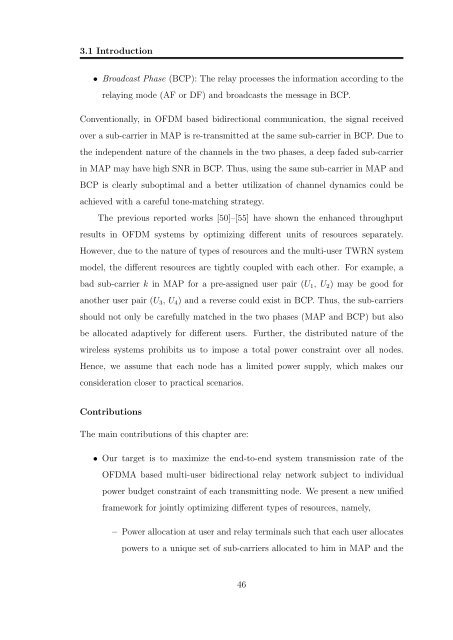Resource Allocation in OFDM Based Wireless Relay Networks ...
Resource Allocation in OFDM Based Wireless Relay Networks ...
Resource Allocation in OFDM Based Wireless Relay Networks ...
You also want an ePaper? Increase the reach of your titles
YUMPU automatically turns print PDFs into web optimized ePapers that Google loves.
3.1 Introduction<br />
• Broadcast Phase (BCP): The relay processes the <strong>in</strong>formation accord<strong>in</strong>g to the<br />
relay<strong>in</strong>g mode (AF or DF) and broadcasts the message <strong>in</strong> BCP.<br />
Conventionally, <strong>in</strong> <strong>OFDM</strong> based bidirectional communication, the signal received<br />
over a sub-carrier <strong>in</strong> MAP is re-transmitted at the same sub-carrier <strong>in</strong> BCP. Due to<br />
the <strong>in</strong>dependent nature of the channels <strong>in</strong> the two phases, a deep faded sub-carrier<br />
<strong>in</strong> MAP may have high SNR <strong>in</strong> BCP. Thus, us<strong>in</strong>g the same sub-carrier <strong>in</strong> MAP and<br />
BCP is clearly suboptimal and a better utilization of channel dynamics could be<br />
achieved with a careful tone-match<strong>in</strong>g strategy.<br />
The previous reported works [50]–[55] have shown the enhanced throughput<br />
results <strong>in</strong> <strong>OFDM</strong> systems by optimiz<strong>in</strong>g different units of resources separately.<br />
However, due to the nature of types of resources and the multi-user TWRN system<br />
model, the different resources are tightly coupled with each other. For example, a<br />
bad sub-carrier k <strong>in</strong> MAP for a pre-assigned user pair (U 1 , U 2 ) may be good for<br />
another user pair (U 3 , U 4 ) and a reverse could exist <strong>in</strong> BCP. Thus, the sub-carriers<br />
should not only be carefully matched <strong>in</strong> the two phases (MAP and BCP) but also<br />
be allocated adaptively for different users. Further, the distributed nature of the<br />
wireless systems prohibits us to impose a total power constra<strong>in</strong>t over all nodes.<br />
Hence, we assume that each node has a limited power supply, which makes our<br />
consideration closer to practical scenarios.<br />
Contributions<br />
The ma<strong>in</strong> contributions of this chapter are:<br />
• Our target is to maximize the end-to-end system transmission rate of the<br />
<strong>OFDM</strong>A based multi-user bidirectional relay network subject to <strong>in</strong>dividual<br />
power budget constra<strong>in</strong>t of each transmitt<strong>in</strong>g node. We present a new unified<br />
framework for jo<strong>in</strong>tly optimiz<strong>in</strong>g different types of resources, namely,<br />
– Power allocation at user and relay term<strong>in</strong>als such that each user allocates<br />
powers to a unique set of sub-carriers allocated to him <strong>in</strong> MAP and the<br />
46

















